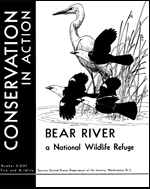United States Fish and Wildlife Service

United States Fish and Wildlife Service: Publications
Date of this Version
2013
Citation
Published by the U.S. Fish and Wildlife Service (2013) 132 pages.
Abstract
As numbers of wild ducks declined and hunting opportunities became more restricted in the mid- 1980s, interest in shooting captive-reared mallards on shooting preserves increased dramatically. In 1985, the U. S. Fish and Wildlife Service (Service) received a series of letters regarding the interpretation of regulations in 50 CFR 21.13 and the practice in Maryland of releasing captive-reared mallards in a freeflying condition on their State-licensed shooting preserves. Prior to this time, shooting preserves released flighted mallards from towers as a general practice to be shot immediately after release and maintained tighter control to prevent these birds from escaping to the wild. The Service responded to the State of Maryland by strictly reiterating the intent of these regulations, mainly “...that such birds may be killed by shooting, in any number, at any time, within the confines of any premises operated as a shooting preserve under State license, permit, or authorization.” Since then, the practice of releasing captive-reared mallards on State-licensed shooting preserves has been more broadly interpreted to allow releases of freeflying birds. As a result of this de facto policy, the number of shooting preserves grew significantly in some areas. However, this practice has become more controversial as large numbers of these birds are being released into areas where they are free to intermingle with wild populations of migratory waterfowl.
At the urging of the four Flyway Councils and the International Association of Fish and Wildlife Agencies (now Association of Fish and Wildlife Agencies, AFWA), the Service was asked to conduct a review of the potential conflicts of releasing free-flying captive-reared mallards on State-licensed shooting preserves and to assess the resulting effects upon migratory waterfowl. With assistance from States and Flyway Councils, all aspects pertaining to enforcement of various regulatory statutes, genetic introgression, disease transmission, and impacts upon waterfowl management programs of wildlife agencies (e.g., population monitoring, banding, and harvest surveys) were examined during 2001-02, including authority and jurisdiction under the Migratory Bird Treaty Act (MBTA).
Based upon this review, the Service’s Division of Migratory Bird Management concludes that releasing and shooting of captive-reared mallards on shooting preserves results in greater potential for violations of regulatory statutes, in particular, Federal waterfowl hunting regulations involving live decoys, baiting, over-bagging, and take of wild ducks out of season. The inability to distinguish between captive-reared and wild mallards in flight and the potential for problems caused by these birds intermixing, both on and off shooting preserves, are at the heart of law-enforcement issues regarding releases of free-flying captive-reared mallards on shooting preserves. If a hunter happens to take a wild duck on a shooting preserve, all hunting prohibitions will apply to that “take.”

